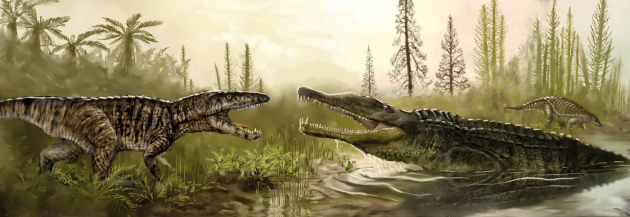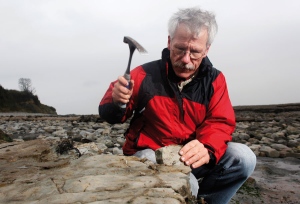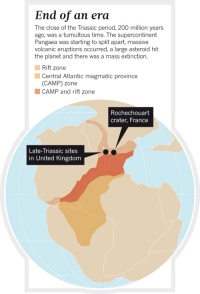Dark days of the Triassic: Lost world
Did a giant impact 200 million years ago trigger a mass extinction and pave the way for the dinosaurs?

VICTOR O. LESHYK
Extinctions
at the end of the Triassic period killed off top predators such as
Redondavenator (left), seen in an artist's impression confronting an
aquatic phytosaur.
Olsen and Kent park their rental car in a muddy lay-by. A slow rain begins to fall and low peals of thunder can be heard in the distance. Grumbling good-naturedly about the British climate, the two geoscientists shrug into their parkas, sling their rucksacks over their shoulders and start down the slick path for another afternoon of getting cold, wet and muddy in the search for clues to mysterious events that wiped out much of life on Earth 200 million years ago and allowed the dinosaurs to take over the world.
How the dinosaurs' mighty reign ended has been fairly well established: a catastrophic asteroid impact near Chicxulub on the Yucatan Peninsula in Mexico, just over 65 million years ago, is widely credited with bringing the age of the dinosaurs to a close and ushering in the age of mammals.
Olsen and Kent, who both work at Columbia University's Lamont-Doherty Earth Observatory in Palisades, New York, have long speculated that with Chicxulub, history might have been repeating itself: that another asteroid, 135 million years earlier, could have wiped out, or at least had a hand in wiping out, much of the late-Triassic flora and fauna. This would have allowed dinosaurs to spread around the globe during the subsequent Jurassic period (200 million to 145 million years ago), evolve enormous bodies and dominate the planet until the next great impact catastrophe.
Sudden death
It is certain that something drastic did happen at the end of the Triassic, because in the space of a few thousand years, half of all genera known to have existed at the time suddenly vanish from the fossil record. At sea, 20% of all families abruptly disappear, including an entire class of creatures — the eel-shaped conodonts. On land, the death toll was even higher. It was one of the greatest mass extinctions in Earth's history and, at this vast distance in time, one of the least understood. “The only thing anyone can say with any certainty about the Triassic–Jurassic mass extinction is that it happened,” says Olsen. “Whatever it was that caused it, it happened so swiftly that most life forms never had time to adapt and evolve to meet the changes.”The prevailing view among scientists these days is that the extinctions were caused by massive volcanic activity associated with the break-up of the super-continent Pangaea. The series of eruptions created a vast geologic formation called the Central Atlantic magmatic province (CAMP; see 'End of an era'). “We are talking here about volcanic activity on a scale many thousands of times greater than anything ever witnessed by humans,” says Gregory McHone, an independent Canadian geologist who has spent much of his career investigating the CAMP volcanic event and building a convincing case for its involvement in the Triassic–Jurassic mass extinction.
The flood-basalt eruption of the Icelandic volcano Laki in 1783 provides researchers with a scaled-down model of just how bad things might have been in the late Triassic. An outpouring of sulphurous gases from Laki created haze that cooled the planet and caused widespread crop failures and famine. It ultimately contributed to the deaths of an estimated 6 million people, says McHone. But disastrous as Laki's eruption was, it belched up just 15 cubic kilometres of basalt. The CAMP events produced 2 million cubic kilometres or more, in a series of pulses that alternated between cooling the climate with sulphurous haze and warming it with massive emissions of carbon dioxide and methane. The oceans grew acidic and parts became starved of oxygen, while on land a surge in lightning sparked extensive fires1. Many of Earth's life forms simply couldn't recover from that succession of body blows, says McHone.
It's a plausible theory, as Olsen and Kent both readily concede — even, perhaps, the most likely one. All the same, the CAMP theory leaves a lot of unanswered questions, not least of which is the suddenness of the extinctions. The late-Triassic eruptions span hundreds of thousands of years, but the die-offs seem swift in the fossil record. And what of the 'fern spike'? Late-Triassic sediments on the US east coast contain huge quantities of fossilized fern spores.
Ferns are usually the first plant to appear after a natural disaster, says Kent. “If you look in the fossil record you see a sudden massive spike in ferns just around the time of the extinctions, but demonstrably before the great basalt flows — at least in our part of the United States.” In other spots, the extinctions seem to coincide with the oldest basalt layers, within the errors of the dating conducted so far.
“The only way we are ever going to unravel this mystery is to work out a timeline, as precise as we can make it, of all the various events around the world that led up to it,” says Kent. Pursuit of that timeline has taken Olsen and Kent on a global quest, from North Carolina to Nova Scotia, Canada; China to Germany, Italy, Austria and the High Atlas Mountains in Morocco; and now to Wales.
Just in time
Olsen has been thinking about the possibility of an impact connection to the Triassic–Jurassic extinctions for more than 20 years2, 3, but one of the biggest drawbacks to the asteroid theory is that until recently nobody had found any evidence of such a catastrophe occurring around the time of the extinctions. Then, last year, French and German research teams re-dated a badly eroded structure left by a massive impact near Rochechouart, in western France4. Previous work had put the impact at around 214 million years ago, long before the extinction event. But the revised date of 199 million to 203 million years ago overlaps with the extinctions, which have been dated to 201.4 million years ago5.The authors of the paper also suggested that the enormous shock waves generated by the 2-kilometre asteroid, as it slammed to Earth at more than 25 kilometres per second, could account for unexplained ripples and disturbances in the late Triassic limestone and shale beds in western Britain — sedimentary beds that coincide with the mass-extinction event. “When I read that,” says Olsen, “I decided it was time to come over here and take a much closer look.”

AP/JIM ROSS
Paul Olsen inspects rocks along a beach in Wales to trace what caused one of the biggest mass extinctions on Earth.
Olsen's fascination with this lost world goes back to 1968, when he was a 14-year-old in Livingston, New Jersey, and heard that dinosaur footprints had been found in the rocks of the nearby Roseland quarry. He and a school friend hopped on their bikes, pedalled over to the quarry and found that there were fossils everywhere.
By the time the two friends were in their second year of high school, they had catalogued thousands of fossils and tracks of reptiles from the late Triassic and early Jurassic. They became so involved that when the quarry and its treasures were to be sold off and developed into housing units, the teens mounted a publicity campaign to save it.
Soon, Life magazine was on the phone and their campaign had captured national attention. Olsen even made a cast of a footprint left by a fearsome three-toed beast, and sent the fibreglass model to then-US president Richard Nixon.
The publicity garnered by this sheer chutzpah helped to protect the fossil-rich site, and the fibreglass footprint went on to find a place in Richard Nixon's presidential library.
Olsen's trip through western Britain with Kent retains some of that sense of schoolboy enterprise and science on the human scale: the two researchers bicker amiably over which way to go at the crossroads; stop off in the local supermarket to pick up more plastic sandwich bags for their rock specimens; use a self-modified, battery-powered drill to take core samples; and even get scolded by the waspish landlady at their guest house when they clomp in with muddy boots at the end of the day.
Explosive force
At Lavernock Point, the scientists ignore the rain and thunder as they set about their work. Olsen makes his way to the base of the cliffs and points to a layer of buff-coloured limestone at about waist height. “Right there is where it happened: there's the extinction line,” he says. To a layman, it is innocuous: just another of the alternating bands of limestone and shale that are brightened here and there by clumps of flowering purple valerian. But close examination reveals sand-filled cracks and deposits of grainy, irregularly sized material — disturbances that might have been the work of a tsunami or an extraordinary earthquake.The disturbed layers here and at other late-Triassic sites in the United Kingdom have a distinctive orientation, all angled as if the source of the unrest was in the vicinity of Rochechouart, says Olsen.
It certainly would have been an awful day in this part of the world when the Rochechouart crater formed. The researchers who re-dated it estimate4 that the impact would have generated an earthquake up to magnitude 11.5 — 100 times more powerful than any quake in recorded history.
“It happened so swiftly that most life forms never had time to adapt and evolve.”
That debris would have carried a chemical signature of the impact that might still reside in the layers of sedimentary rocks. Stratigrapher Stephen Hesselbo and geochemist Ken Amor, both at the University of Oxford, UK, have joined Olsen and Kent on their outing, and are taking samples to analyse with a mass spectrometer. They will measure the ratios of chromium isotopes, and look for one that is characteristic of meteorites. Olsen will also send samples from this location to another lab, to be searched for other tell-tale impact markers.
If those tests detect an extraterrestrial signal in the late-Triassic sedimentary layers in Wales and elsewhere, it will be the first substantive link between an impact and the Triassic–Jurassic mass-extinction event. But a coincidence in time won't prove that an impact was the cause. “The two things might occur at approximately the same moment but have nothing whatever to do with each other,” says Olsen.
More troublingly, the Rochechouart impact doesn't seem to have been anywhere near big enough to have accounted for the mass extinctions around the globe — at least, not on its own. The 25-kilometre-wide buried crater may have been 40 to 50 kilometres across originally, but it is just a pockmark in comparison with the 180-kilometre-wide scar at Chicxulub. “Based on our estimates, Rochechouart is quite small in terms of global environmental consequences,” says Collins.
Picking up the pieces
For now, says Olsen, it is too early to make any definitive statements about what Rochechouart did or didn't do. That will take much more data from late-Triassic sites around the world. This year alone, he has crossed the Atlantic three times to collect samples from the United Kingdom and Morocco. He is back in the Atlas Mountains this week, to examine yet more sites. He and his colleagues are not only looking for signs of an extraterrestrial impact in the sediments, but are also searching for other clues, such as the extinction layer and a chemical signature that could be linked to the CAMP eruptions. All those data, says Olsen, will help the team to sort out the relative timing of events around the world, and to create a fuller picture of what happened and how life responded.He suspects that Rochechouart may have been “a piece of a much bigger puzzle”. Perhaps it was one of a series of asteroids that hit around the same time. Alternatively, a lone French crash might have been the final straw for a world already reeling from volcanic eruptions. Or the impact may have come first, weakening ecosystems enough that when the eruptions started, life took a nosedive.
Teasing out the answer will take some time, says Olsen, as he trudges, wet and muddy, back up the trail at the end of another wearying afternoon in the cold Welsh rain. “There is no easy way to do this,” he says. “But I believe that eventually we will be able to put the pieces together and know what happened and why.”
- Nature
- 479,
- 287–289
- ()
- doi:10.1038/479287a

Nenhum comentário:
Postar um comentário
Observação: somente um membro deste blog pode postar um comentário.